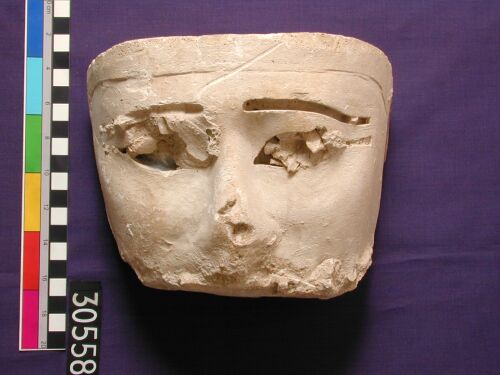| Homepage | Timeline | Maps | A-Z index | Learning |
Saqqara: the Sacred Animal Necropolis: Mastaba 3518
a sculpture model

This head belongs to a group of objects often called 'sculptors' models'. About 2000 'sculptors' models' are so far known dating mostly to the Ptolemaic Period, but many may be earlier. There are two main types: models of sculpture (kings' heads, female busts, Hathor, Bes figures, torsos, lions, lion heads, bulls etc.) and models in relief (animals, kings' heads etc.). They are most often made in limestone; the back is always flat, many still show traces of grids (UC 15507); others seems to be unfinished. Several are painted and some are even gilded. Some of them have a hole (for hanging them on a wall).
The function of these 'models' is disputed with two principal rival interpretations: (1) real models used as prototypes in sculpture workshops; or (2) they are votive offerings. The interpretation as workshop models is problematic, because on the reliefs many scenes known from temple reliefs are missing. The interpretation as votive offerings seem more likely from the few archaeological contexts for such material. At Saqqara a group of models (including UC 30558) were found deposited next to an Old Kingdom mastaba (Tomb 3518). However, the two interpretations are not necessarily entirely exclusive; sculpting was a sacred activity (see the ritual for opening the mouth), and it might have been considered appropriate to offer by-products from the process, or even manufactured imitations of them, for deposition as votive offerings.
sculpture models | models in relief
further models found at Saqqara (of arms)
UC 30604 | UC 30605 | UC 30606
bibliography:
|